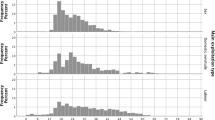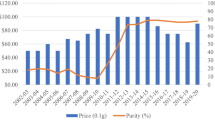Abstract
Although adolescents living on the street tend to have unprotected sex with many partners and substance abuse, little is known about this reality in Brazil. To estimate the prevalence and factors associated with risky sexual behavior among children and adolescents living on the street in Porto Alegre and Rio Grande. A cross-sectional study was carried out using the Respondent-Driven Sampling (RDS) sampling method to quickly and efficiently access populations of difficult access. Poisson regression with robust adjustment of variance was used in the multivariate analysis. The sample consisted of 231 participants aged 10–21 years. Most were male and aged 16- 21 years. More than half (66.7%) of the respondents did not have a school bond, and 64.5% did not live with the family. Half of the sample had been living on the street for at least four years, spending 15 h or more on the street. Most (86.6%) responded that they had already used illicit drugs in their lives, and unprotected sex prevalence was 61.9%. The variables independently associated with unprotected sex were years living on the street, hours spent on the street, having a steady partner, illicit drug use, and sexual intercourse without a condom under the influence of drugs. The high prevalence of unprotected sex points to the need for intervention policies for this population to prevent the main risk factors.

Similar content being viewed by others
References
Cutuli, J. J. (2018). Homelessness in high school: Population-representative rates of self-reported homelessness, resilience, and risk in Philadelphia. Social Work Research, 42, 159–168. https://doi.org/10.1093/swr/svy013
Sicari AA, Zanella AV. (2018). Pessoas em situação de rua no Brasil: Revisão sistemática. Psicologia: ciência e profissão, 38: 662–679. https://doi.org/10.1590/1982-3703003292017
Heerde, J. A., & Hempill, S. A. (2016). The role of risk and protective factors in the modification of risk for sexual victimization, sexual risk behaviors, and survival sex among homeless youth: A meta-analysis. J Investig Psychol Offender Profil, 14, 150–174. https://doi.org/10.1002/jip.1473
Matos, T. N. F., Trajano, S. S., Caldas, J. M. P., & Catrib, A. M. F. (2017). Representações sociais e de saúde em moradores de rua. Sanare, 16, 17–22.
Aldridge, R. W., Story, A., Hwang, S. W., et al. (2018). Morbidity and mortality in homeless individuals, prisoners, sex workers, and individuals with substance use disorders in high-income countries: A systematic review and meta-analysis. The Lancet, 391, 241–250. https://doi.org/10.1016/S0140-6736(17)31869-X
Boyer, C. B., Greenberg, L., Chutuape, K., et al. (2017). Exchange of sex for drugs or money in adolescents and young adults: An examination of sociodemographic factors, HIV related risk, and community context. Journal of Community Health, 42, 90–100. https://doi.org/10.1007/s10900-016-0234-2
Vallès, X., Lusala, P. L., Devalière, H., et al. (2016). Network analysis of knowledge and practices regarding sexual and reproductive health: A study among adolescent street girls in Kinshasa (DRC). The European Journal of Contraception & Reproductive Health Care, 22, 62–69. https://doi.org/10.1080/13625187.2016.1262023
Barman, A. A., Hsu, H. T., Begun, S., et al. (2017). Condomless Sex Among Homeless Youth: The role of multidimensional social norms and gender. AIDS and Behavior, 21, 688–702. https://doi.org/10.1007/s10461-016-1624-2
Hsu, H. T., Fulginiti, A., Rice, E., & Rhoades, H. (2018). But everyone is doing it (sort of)! Perceived sexual risks in the social environment and the impact on homeless youth engagement in concurrent sexual relationships. AIDS and Behavior, 22, 3508–3518. https://doi.org/10.1007/s10461-018-2133-2
Herrera, C. N., Rojas, C. A., & Jiménez, L. C. (2016). HIV prevalence in children and youth living on the street and subject to commercial sexual exploitation: A systematic review. Cadernos de Saúde Pública, 32, 1–12. https://doi.org/10.1590/0102-311X00134315
Heckathorn, D. D. (1997). Respondent-driven sampling: A new approach to the study of hidden populations. Social problems, 44, 174–199. https://doi.org/10.2307/3096941
Carvalho, F. T., Neiva-Silva, L., Ramos, M. C., et al. (2006). Sexual and drug use risk behaviors among children and youth in street circumstances in porto alegre Brazil. AIDS and Behavior, 10, 57–66. https://doi.org/10.1007/s10461-006-9124-4
Brasil. (1990). Dispõe sobre o Estatuto da Criança e do Adolescente e dá outras providências. Lei n, 8069.
Neiva-Silva L. (2008). Uso de drogas entre crianças e adolescentes em situação de rua: Um estudo longitudinal
Neiva-Silva L, Carvalho FT, Paludo S, et al. (2010). Estudo comportamental com crianças e adolescentes em situação de rua em Porto Alegre e Rio Grande: uso da técnica de Respondent Driven Sampling (RDS) para identificação de comportamentos sexuais de risco e uso de drogas. Relatório Técnico Analítico Final de Pesquisa do Programa Nacional de DST/AIDS
Mayo-Wilson, L. J., Mathai, M., Yi, J., et al. (2020). Lessons learned from using respondent-driven sampling (RDS) to assess sexual risk behaviors among Kenyan young adults living in urban slum settlements: A process evaluation. PLoS ONE, 15, 1–22. https://doi.org/10.17632/xdk2frn44k.1
Salganick, M. J., & Heckathorn, D. D. (2004). Sampling and estimation in hidden populations using respondent-driven sampling. Sociological Methodology, 34, 193–240. https://doi.org/10.1111/j.0081-1750.2004.00152
Barros, A. J., & Hirakata, V. N. (2003). Alternatives for logistic regression in cross-sectional studies: An empirical comparison of models that directly estimate the prevalence ratio. BMC Medical Research Methodology, 21, 1–13. https://doi.org/10.1186/1471-2288-3-21
Victora, C., Huttly, S., Fuchs, S., Olinto, T., et al. (1997). The role of conceptual frameworks in epidemiologic analysis: A hierarchical approach. International Journal of Epidemiology, 26, 224–227. https://doi.org/10.1093/ije/26.1.224
Shanna, K., Kattari, A., Barman, A., et al. (2017). Social networks and sexual risk factor differences between cisgender heterosexual and cisgender LGBQ homeless youths. Journal of Gay & Lesbian Social Services, 29, 182–200. https://doi.org/10.1080/10538720.2017.1296800
Kamke, K., Widman, L., & Haskett, M. (2019). Safer sex communication and sexual health behaviors among a representative statewide sample of homeless adolescents. The Journal of Sex Research, 57, 137–144. https://doi.org/10.1080/00224499.2019.1577945
Chimdessa, A., & Cheire, A. (2018). Sexual and physical abuse and its determinants among street children in Addis Ababa, Ethiopia 2016. BMC Pediatrics, 304, 1–8. https://doi.org/10.1186/s12887-018-1267-8
Kakchapati, S., Shrestha, B., & Li, D. (2018). Drug use, injecting behaviors, and survival sex among street children and youths in Kathmandu valley Nepal. International Journal of STD & AIDS, 29, 588–597. https://doi.org/10.1177/0956462417746532
Almeida, M. C. C., Aquino, E. M. L., Gaffikin, L., & Magnani, R. J. (2003). Uso de contracepção por adolescentes de escolas públi¬cas na Bahia. Rev Saúde Pública, 37, 566–575. https://doi.org/10.1590/S0034-89102003000500004
Geluda, K., Bosi, M. L. M., Cunha, A. J. L. A., & Trajman, A. (2006). Quando um não quer, dois não brigam: Um estudo sobre o não uso constante de preservativo masculino por adolescentes do Município do Rio de Janeiro Brasil. Cadernos de Saúde Pública, 22, 1671–1680. https://doi.org/10.1590/S0102-311X2006000800015
Brasil.(2003). Secretaria Nacional Antidrogas. Levantamento nacional sobre o uso de drogas entre crianças e adolescentes em situação de rua nas 27 capitais brasileiras
Author information
Authors and Affiliations
Corresponding author
Additional information
Publisher's Note
Springer Nature remains neutral with regard to jurisdictional claims in published maps and institutional affiliations.
Rights and permissions
About this article
Cite this article
Hartmann, C.F., Silva, L.N., Corrêa, M.L. et al. Risky Sexual Behavior Among Street Children, Adolescents, and Young People Living on the street in southern Brazil. J Community Health 46, 1188–1196 (2021). https://doi.org/10.1007/s10900-021-01010-2
Accepted:
Published:
Issue Date:
DOI: https://doi.org/10.1007/s10900-021-01010-2




